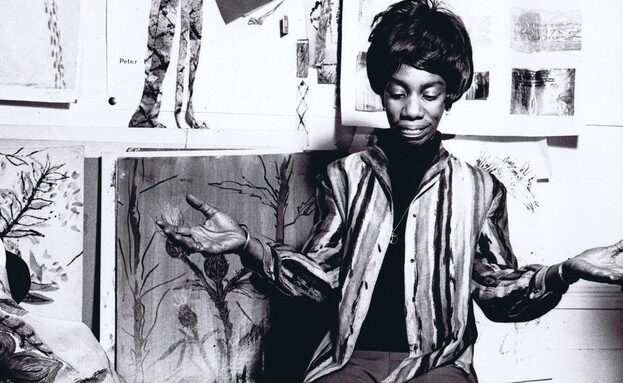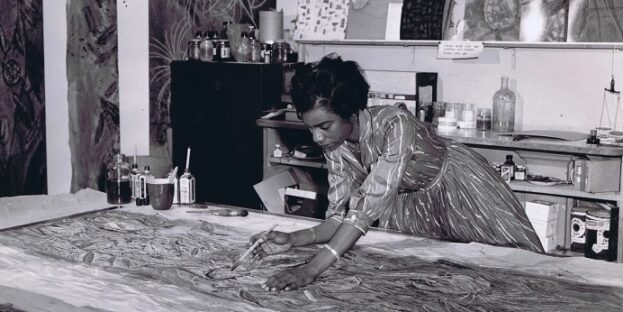
You are warmly invited to join us in unveiling a London Blue Plaque to legendary international textile designer, Althea McNish. It’ll be the 84th Nubian Jak plaque.
IKEA in Tottenham might seem an improbable favourite haunt for an icon of British design, but before her death in 2020, aged 96, that is where you would often find Althea McNish.
She would peruse the showrooms, dressed head to toe in the bright, bold and sensuous fabrics she designed. “She would point out things and say they needed more colour – she always had a glint in her eye,” remembers Rose Sinclair, curator of the first major exhibition on McNish at the William Morris Gallery, Colour Is Mine.
Born in a middle-class family in Port of Spain, Trinidad and Tobago, in 1924, McNish was already a successful painter when she arrived in the UK in November 1950. She attended the London College of Printing, and evening classes at Central St Martins, where she met the likes of Eduardo Paolozzi. In 1954, she enrolled at the Royal College of Art, where she studied textile design – and was one of few women of colour at the prestigious art school.
“My designing is functional but free, you can wear it, sit on it, lie on it, stand on it,” McNish said of her work, which she described as a “statement of my being”. She quickly became known as much for her technical acuity and understanding of the commercial side of design as for her painterly approach – applying brushes directly to silkscreen, and using monoprinting to create the sketches and experiment with colourways for her inimitable, intricately layered style. “She was confident and competent – and that was projected into her work,” says Sinclair.
The day after her graduation from the RCA in 1958, McNish presented her portfolio at Liberty’s – and was commissioned on the spot to create a collection. One of those designs, Marina, is on show at William Morris Gallery, and Liberty is reissuing a capsule collection of 12 of McNish’s fabrics as limited editions – the first time they have been available to buy in decades.
Playing on a projector at the exhibition is rare video footage following an immaculately dressed McNish at work, and in discussion with fashion designers. One of her significant contributions to the industry was her decision to collaborate closely with designers from the beginning of the creative process, so that she could adapt her textiles to suit their purpose.

Though McNish considered Britain her second home, Trinidad was never far from her mind. In two rare early paintings made soon after she arrived in the UK, figures appear in lush, rural landscapes on the island; a third painting on display, made from memory, captures the vibrant energy of the hosay festival, an annual Indo-Muslim celebration that all Trinidadians took part in. Flora, fauna and Carnival would continue to inspire McNish throughout her career. The paintings are the only surviving works in the medium by McNish, whose archive and legacy have been hampered by a lack of care and attention until recently.
McNish’s most popular fabric designs were inspired by her early life in Trinidad, but they also showcase the way she scaled up and transformed English flowers “into Caribbean flamboyance” (as McNish herself put it), reinventing British landscapes. In the Essex wheat fields she portrays in the spectacular Golden Harvest (a bestselling furnishing fabric produced for Hull Traders in the 1960s which stayed in production for two decades), McNish was reminded of the verdant glow of the sugarcane fields in her birthplace. She drew inspiration from everywhere – as she stated, “I don’t have to look very far, it’s usually objects right at hand that come to my aid. I see an idea in an onion, cabbage or any other item lying around the studio.”
But there was also a strong social and political current in McNish’s interest in nature and in the decorative arts, too. “Many of these designs were produced in an era when Enoch Powell was making his 1968 Rivers of Blood speech,” says Sinclair, “suggesting migrants in this country should be sent ‘back home’ – and here’s Althea decorating British spaces with her homeland.” This was underscored by McNish’s involvement with the Caribbean Artists Movement, an influential group of artists, writers, and musicians from the Caribbean active from 1966 to 1972, advocating for the importance of contributions of artists of colour in Britain.
“She knew what it meant to champion this new aesthetic, to keep challenging and changing the canon,” Sinclair notes. “She was a quiet activist – she showed her agency, her heritage, and herself through her work – and she didn’t let anything hold her back.”
But there was also a strong social and political current in McNish’s interest in nature and in the decorative arts, too. “Many of these designs were produced in an era when Enoch Powell was making his 1968 Rivers of Blood speech,” says Sinclair, “suggesting migrants in this country should be sent ‘back home’ – and here’s Althea decorating British spaces with her homeland.” This was underscored by McNish’s involvement with the Caribbean Artists Movement, an influential group of artists, writers, and musicians from the Caribbean active from 1966 to 1972, advocating for the importance of contributions of artists of colour in Britain.
“She knew what it meant to champion this new aesthetic, to keep challenging and changing the canon,” Sinclair notes. “She was a quiet activist – she showed her agency, her heritage, and herself through her work – and she didn’t let anything hold her back.”
Red More about this event here
When: 11.30am Monday 15th May 2023
Where: 142 West Green Road, N15 5AD
